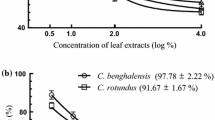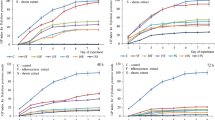Abstract
Herbicides are commonly used to control weed. However, some plants are resistant to such products. To identify less harmful herbicides, it is crucial to search for different mechanisms of action. Thymol is an easily acquired allelopathic compound, capable of producing its respective semisynthetic derivative, thymoxyacetic acid. The aim of this study was to determine the effects of thymol and thymoxyacetic acid molecules as bioherbicides in greenhouse at the concentration of 3 mmol L−1 in pre- and postemergence applications in five species: Amaranthus viridis L., Cucumis sativus L., Lactuca sativa L., Eleusine indica L., and Sorghum bicolor L. The initial seedling development and DNA changes were analyzed. These molecules were contrasting with the solvent, in the negative control, and with the glyphosate, in the positive control, promoting phytogenotoxic activities. The toxic effect of thymoxyacetic acid was more effective in preemergence and thymol’s in postemergence. We also observed a reduction in the germination speed index and root growth with a negative correlation to the increase in potassium leaching. Damage to the root and shoot of the seedlings was verified at the DNA level, and the phytotoxicity of the plants treated with the herbicide glyphosate was similar to the plants treated with the natural molecules tested. The bioherbicidal effect of thymol and thymoxyacetic acid exacerbates the reduction of the environmental impact caused by the disordered and increased use of residual pesticides.








Similar content being viewed by others
Data availability
The datasets generated during and/or analyzed during the current study are available from the corresponding author on reasonable request.
References
Abu-Romman S, Shatnawi M, Shibli R (2010) Allelopathic effects of spurge (Euphorbia hierosolymitana) on wheat (Triticum durum). American-Eurasian J Agric and Environ Sci 7:298–302
Aires SS, Ferreira AG, Borghetti F (2005) Efeito alelopático de folhas e frutos de Solanum lycocarpum A. St.-Hil. (Solanaceae) na germinação e crescimento de Sesamun indicum L. (Pedaliaceae) em solo sob três temperaturas. Acta Bot Bras 19:339–344. https://doi.org/10.1590/S0102-33062005000200017
Alves TA, Pinheiro PF, Praça-Fontes MM, Andrade-Vieira LF, Corrêa KB, Alves TA, Cruz FA, Lacerda Júnior V, Ferreira A, Soares TCB (2018) Toxicity of thymol, carvacrol and their respective phenoxyacetic acids in Lactuca sativa and Sorghum bicolor. Ind Crop Prod 114:59–67. https://doi.org/10.1016/j.indcrop.2018.01.071
Amri I, Hamrouni L, Hanana M, Jamoussi B (2013) Reviews on phytotoxic effects of essential oils and their individual components: news approach for weeds management. Int J Appl Biol Pharm 4:96–114
Anazetti MC, Melo OS (2007) Morte Celular por Apoptose: uma visão bioquímica e molecular. Metrocamp Pesquisa 1:37–58
ANVISA (2012) Agência Nacional de Vigilância Sanitária. Seminário de mercado de agrotóxico e regulação
Araniti F, Miras-Moreno B, Lucini L, Landi M, Abenavoli MR (2020) Metabolomic, proteomic and physiological insights into the potential mode of action of thymol, a phytotoxic natural monoterpenoid phenol. Plant Physiol Biochem 153:141–153. https://doi.org/10.1016/j.plaphy.2020.05.008
Azirak S, Karaman S (2008) Allelopathic effect of some essential oils and components on germination of weed species. Acta Agric Scand - B Soil Plant Sci 58:88–92. https://doi.org/10.1080/09064710701228353
Belchior DCV, Saraiva AS, López AMC, Scheidt GN (2017) Impactos de agrotóxicos sobre o meio ambiente e a saúde humana. Cad Ciênc Tecnol 34:135–151
Bohner TOL, Araújo LEB, Nishijima T (2013) O impacto ambiental do uso de agrotóxicos no meio ambiente e na saúde dos trabalhadores rurais. Rev Elet Cur Dir UFSM 8:329–341
Bombardi LM (2017) Geografia do uso de agrotóxicos no Brasil e conexões com a União Europeia. FFLCH-USP
Brighenti AM (2010) Manual for the identification and management of weeds in sugarcane crops. Juiz de Fora: Embrapa Dairy Cattle. 150 p
Cruz CD (2013) GENES: a software package for analysis in experimental statistics and quantitative genetics. Acta Sci Agron 35:271–276. https://doi.org/10.4025/actasciagron.v35i3.21251
Dayan FE, Duke SO (2014) Natural compounds as next-generation herbicides. Plant Physiol 166:1090–1105. https://doi.org/10.1104/pp.114.239061
Dias LC, Demuner AJ, Valente VM, Barbosa LC, Martins FT, Doriguetto AC, Ellena J (2009) Preparation of achiral and chiral (E)-enaminopyran-2, 4-diones and their phytotoxic activity. J Agric Food Chem 57:1399–1405. https://doi.org/10.1021/jf802805f
Doyle JJ, Doyle JL (1990) Isolation of plant DNA from fresh tissue. Focus 12:39–40
Escobar A, Pérez M, Romanelli G, Blustein G (2020) Thymol bioactivity: A review focusing on practical applications. Arab J Chem 13(12):9243–9269. https://doi.org/10.1016/j.arabjc.2020.11.009
Faquin V (2005) Nutrição mineral de plantas. Lavras, Minas Gerais.
Ferreira AG, Aquila MEA (2000) Alelopatia: uma área emergente da ecofisiologia. Braz J Plant Physiol 12:175–204
Ferreira AG, Borghetti F (2004) Germinação: do básico ao aplicado. Artmed Porto Alegre.
Heap I (2020) The International Herbicide-Resistant Weed Database.
Hussain MI, Reigosa MJ (2011) Allelochemical stress inhibits growth, leaf water relations, PSII photochemistry, non-photochemical fluorescence quenching, and heat energy dissipation in three C3 perennial species. J Exp Bot 62:4533–4545. https://doi.org/10.1093/jxb/err161
IBAMA (2020) Relatórios de comercialização de agrotóxicos. http://www.ibama.gov.br/agrotoxicos/relatorios-de-comercializacao-de-agrotoxicos. Acessed 02 march 2022
Kraehmer H, Laber B, Rosinger C, Schulz A (2014) Herbicides as weed control agents: state of the art: I. Weed control research and safener technology: the path to modern agriculture. Plant Physiol 166(3): 1119–1131. https://doi.org/10.1104/pp.114.241901
Kudsk P, Streibig JC (2003) Herbicides – a two-edged sword*. Weed Res 43:90–102. https://doi.org/10.1046/j.1365-3180.2003.00328.x
Leal UA, Silva GN, Karam D (2012) Otimização dinâmica multiobjetivo da aplicação de herbicida considerando a resistência de plantas daninhas. Embrapa Milho e Sorgo-Artigo em periódico indexado (ALICE).
Lorenzi H (2014) Weed Identification and Control Manual: No-tillage and Conventional Planting, 7ª. Plantarum Institute for Flora Studies, Nova Odessa, SP
Maguire JD (1962) Speed of germination—Aid in selection and evaluation for seedling emergence and vigor. Crop Sci 2:176–177. https://doi.org/10.2135/cropsci1962.0011183X000200020033x
Maraschin-Silva F, Aquila M (2006) Potencial alelopático de espécies nativas na germinação e crescimento inicial de Lactuca sativa L. (Asteraceae). Acta Bot Bras 20:61–69. https://doi.org/10.1590/S0102-33062006000100007
Marchi J, Cicero S (2002) Procedimentos para a condução do teste de condutividade elétrica em sementes. Informativo Abrates 12:2
Moraes RF (2019) Agrotóxicos no Brasil: Padrões de uso, política da regulação e prevenção da captura regulatória. https://www.ipea.gov.br/portal/index.php?option=com_content&view=article&id=35016:td-2506-agrotoxicos-no-brasil-padroes-de-uso-politica-da-regulacao-e-prevencao-da-captura-regulatoria&catid=419:2019&directory=1. Acessed 02 march 2022
Oliveira LM, Voltolini JC, Barbério A (2011) Potencial mutagênico dos poluentes na água do rio Paraíba do Sul em Tremembé, SP, Brasil, utilizando o teste Allium cepa. Ambiente & Água-an Int J Appl Sci 6:90–103. https://doi.org/10.4136/ambi-agua.176
Oliveira SCC, Ferreira AG, Borghetti F (2004) Efeito alelopático de folhas de Solanum lycocarpum A. St.-Hil. (Solanaceae) na germinação e crescimento de Sesamum indicum L. (Pedaliaceae) sob diferentes temperaturas. Acta Bot Bras 18:401–406. https://doi.org/10.1590/S0102-33062005000200017
Pinheiro PF, Costa AV, Alves TA, Galter IN, Pinheiro CA, Pereira AF, Oliveira CMR, Fontes MMP (2015) Phytotoxicity and Cytotoxicity of Essential Oil from Leaves of Plectranthus amboinicus, Carvacrol, and Thymol in Plant Bioassays. J Agr Food Chem 63:8981–8990. https://doi.org/10.1021/acs.jafc.5b03049
Prete CEC (1992) Condutividade elétrica do exsudato de grãos de café (Coffea arabica L.) e sua relação com a qualidade da bebida. http://www.sbicafe.ufv.br/handle/123456789/392
Qian H, Xu X, Chen W, Jiang H, Jin Y, Liu W, Fu Z (2009) Allelochemical stress causes oxidative damage and inhibition of photosynthesis in Chlorella vulgaris. Chemosphere 75:368–375. https://doi.org/10.1016/j.chemosphere.2008.12.040
Seth CS, Chaturvedi PK, Misra V (2007) Toxic effect of arsenate and cadmium alone and in combination on giant duckweed (Spirodela polyrrhiza L.) in response to its accumulation. Environ Toxicol 22:539–549. https://doi.org/10.1002/tox.20292
Silva L, Silva A, Queiroz M, Lima C, Rocha P, D’antonino L (2012) Action of Eleusine coracana in the remediation of soils contaminated with picloram. Planta Daninha 30:627–632. https://doi.org/10.1590/S0100-83582012000300019
Silva VS, Cândido ACS, Muller C, Laura VA, Faccenda O, Hess SE, SC, Peres MTLP, (2011) Potencial fitotóxico de Dicranopteris flexuosa (Schrad.) Underw. (Gleicheniaceae). Acta Bot Bras 25:95–104. https://doi.org/10.1590/S0102-33062011000100012
Song Y (2014) Insight into the mode of action of 2,4-dichlorophenoxyacetic acid (2,4-D) as an herbicide. J Integr Plant Biol 56(2):106–113. https://doi.org/10.1111/jipb.12131
Souto AL, Sylvestre M, Tölke ED, Tavares JF, Barbosa-Filho JM, Cebrián-Torrejón G (2021) Plant-Derived Pesticides as an Alternative to Pest Management and Sustainable Agricultural Production: Prospects. Applications and Challenges Molecules 26:4835. https://doi.org/10.3390/molecules26164835
Valerio ME, García JF, Peinado FM (2007) Determination of phytotoxicity of soluble elements in soils, based on a bioassay with lettuce (Lactuca sativa L.). Sci Total Environ 378:63–66. https://doi.org/10.1016/j.scitotenv.2007.01.007
Yang DT, Zhu X (2013) Modernization of agriculture and long-term growth. J Monet Econ 60:367–382. https://doi.org/10.1016/j.jmoneco.2013.01.002
Zunino MP, Zygadlo JÁ (2004) Effect of monoterpenes on lipid oxidation in maize. Planta 219:303–309. https://doi.org/10.1007/s00425-004-1216-7
Funding
The authors thank the “Conselho Nacional de Desenvolvimento Científico e Tecnológico” (CNPq, Brasília—DF, Brazil) for funding (number: 408775/2018–1) and for the research grant to Milene Miranda Praça-Fontes, Patrícia Fontes Pinheiro and Taís Cristina Bastos Soares; the “Coordenação de Aperfeiçoamento de Pessoal de Nível Superior” (CAPES), for the financial support (Finance Code 001) and “Fundação de Amparo à Pesquisa e Inovação do Espírito Santo” (FAPES, Vitória – ES, Brazil) for funding (grant 484/2021;2021-ZK8PJ and Cooperação CAPES/FAPES – PDPG) and for providing undergraduate research and master’s scholarships to the authors of this work.
Author information
Authors and Affiliations
Contributions
All authors contributed to the study conception and design. Material preparation, data collection and analysis were performed by Carlos Eduardo de Oliveira Roberto, Patrícia Fontes Pinheiro, Thammyres de Assis Alves, Josimar Aleixo da Silva, Milene Miranda Praça-Fontes, Taís Cristina Bastos Soares. The first draft of the manuscript was written by Carlos Eduardo de Oliveira Roberto and all authors commented on previous versions of the manuscript. All authors read and approved the final manuscript.
Corresponding author
Ethics declarations
Ethics approval
Not applicable.
Consent to Participate
Not applicable.
Consent for publication
Not applicable.
Competing interests
The authors declare that they have no conflict of interest.
Additional information
Responsible Editor: Gangrong Shi
Publisher's note
Springer Nature remains neutral with regard to jurisdictional claims in published maps and institutional affiliations.
Rights and permissions
Springer Nature or its licensor (e.g. a society or other partner) holds exclusive rights to this article under a publishing agreement with the author(s) or other rightsholder(s); author self-archiving of the accepted manuscript version of this article is solely governed by the terms of such publishing agreement and applicable law.
About this article
Cite this article
de Oliveira Roberto, C.E., Pinheiro, P.F., de Assis Alves, T. et al. Phytogenotoxicity of thymol and semisynthetic thymoxyacetic acid in pre/post emergence of model plants and weeds. Environ Sci Pollut Res 30, 38955–38969 (2023). https://doi.org/10.1007/s11356-022-24753-4
Received:
Accepted:
Published:
Issue Date:
DOI: https://doi.org/10.1007/s11356-022-24753-4




